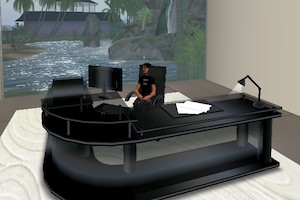 1. Financial Times (UK) – Game on for the virtual sweatshop. “I’m a board game fan myself, but I know that millions of people spent their Christmas exploring the underwater realm of Vashj’ir, thanks to the online computer game, World of Warcraft, which launched a new version, Cataclysm, in December. Loyal readers will know why economists find such games interesting: they are virtual worlds in which millions of people spend many hours interacting, creating experiences and goods that other players value, and even spending real money on virtual items. (Crazy? No more crazy than paying to watch a movie.) Facebook applications such as FarmVille have many more users. But it is the great online role-playing games – and none is bigger than World of Warcraft, with 12 million users paying a monthly subscription – which hold an enduring fascination for the way that they blur the line between virtual life and real life.”
1. Financial Times (UK) – Game on for the virtual sweatshop. “I’m a board game fan myself, but I know that millions of people spent their Christmas exploring the underwater realm of Vashj’ir, thanks to the online computer game, World of Warcraft, which launched a new version, Cataclysm, in December. Loyal readers will know why economists find such games interesting: they are virtual worlds in which millions of people spend many hours interacting, creating experiences and goods that other players value, and even spending real money on virtual items. (Crazy? No more crazy than paying to watch a movie.) Facebook applications such as FarmVille have many more users. But it is the great online role-playing games – and none is bigger than World of Warcraft, with 12 million users paying a monthly subscription – which hold an enduring fascination for the way that they blur the line between virtual life and real life.”
2. Techdirt (USA) – Second Life Dragged Into Legal Dispute Over Copyright Of Virtual Horses And Virtual Bunnies. “Way back in 2003, we warned that Second Life’s copyright policy was going to be trouble. While many people celebrated the fact that Second Life had announced that participants would “own” the copyright on any works they created within the game, we feared that this would bring real world legal disputes into a virtual world that didn’t make much sense — and in retrospect many of the problems we expected have come true, though it’s been mitigated by the fact that Second Life has lost a lot of its popularity over the past few years. That said, Eric Goldman has the details on a recent bizarre legal dispute, which is summarized by the judge in the case as follows: “The gist of the copyright dispute between the parties is whether Plaintiff’s virtual horses infringe on copyrights associated with Defendant’s virtual bunnies.” Yeah, so you know you’re in for a treat. The details are that one company, Ozimals, makes “breedable” animals within Second Life, and believed that a competing company, Amaretto Ranch Breedables, was infringing on its copyrights.”
3. Tech News World (USA) – Avatar Kinect Puts Your Best Face Forward. “vatar” movie director James Cameron couldn’t have scripted a better keynote speech for Microsoft (Nasdaq: MSFT) CEO Steve Ballmer, who announced at the Consumer Electronics Show in Las Vegas Wednesday that Kinect and Xbox will connect with consumers via avatars, transporting Xbox Live Gold subscribers into the chatty, motion-savvy, virtual world of Avatar Kinect. “We will make entertainment more interactive, more social, and more fun for everyone, and we’ll do it like no one else can,” said Ballmer, speaking on-screen as a slendered-down avatar version of himself. Currently, Kinect listens to your voice and tracks your body movements, avatar Ballmer added. “But what about your facial movements? Now, Kinect can track features like your smile, your laugh, and even the raise of your eyebrows.”
4. Games On Net (Australia) – Minecraft Now Has Over 3 Million Registered Users. “Minecraft, the smash hit game of exploration, construction, and zombie combat, now has over three million registered users. Surprisingly, most of those players are still frolicking in the virtual worlds of Minecraft Classic; just under one million users have actually bought and paid for the game. Ever the optimist, Minecraft creator Markus ‘Notch’ Persson has stated via twitter that he does not think ill of those two million freeloaders. Instead, he likes to think of them as possible future customers.”
5. Big Think (USA) – Biometrics Goes Mainstream. “Biometrics will begin reaching a mainstream audience, and that will change how we see our health and fitness and open up new vistas for the health care industry and personal control around health and wellness. We will see the beginning of the end of the wallet as it begins to move into our smart phones in ways that make it clear what’s happening to the common observer. Virtual currencies will start to move outside of virtual worlds and social games into other media experiences. We’ll see a flood of online marketplaces that helps us make better economic use of currently under-used personal assets such as cars, extra rooms in your house, tools and toys in your garage, and under-used corporate assets like empty conference rooms, limos + town cars, reservations at restaurants and spas, airline seats, etc.”
6. Military and Aerospace Electronics (USA) – Designs for avionics and synthetic vision rely heavily on human factors research. “People interact with machines in different ways — with their eyes, touch, voices, and even their brain waves. These human factors are important when designing cars, home theaters, and especially commercial and military aircraft cockpits. Telepathic flight control still resides in fictional realms such as the 1982 Clint Eastwood movie FireFox — in which a pilot stole a Soviet jet fighter that was programmed to respond to human thoughts. The Eastwood character controlled the fictional high-performance jet by thinking in Russian. Today, however, avionics designers are exploring touch screens, virtual worlds, 3-D moving maps, and even voice control in all types of cockpits. “We are passionate about the user experience on the flight deck, going beyond human factor issues so pilots can do what they need to do,†says Sarah Barber, systems engineer and human factors expert for Rockwell Collins in Cedar Rapids, Iowa. “There is nothing worse than having frustrated pilots on the flight deck. We focus on what the sensation of perception pilots get from the flight deck display.â€
7. Salon (USA) – 3-D is coming to your home. “I’ve been a skeptic about 3-D in its initial phases. Hollywood has used the technology mainly to increase movie prices, and the experience in theaters — with few exceptions, such as James Cameron’s “Avatar” — has been nowhere near worth the higher ticket price. This is one reason, by all accounts, that 2010 movie attendance dropped. At last year’s Consumer Electronics Show in Las Vegas, 3-D got its first big push into the home entertainment market, but it looked more like a gimmick than anything most people would care about in the near term. This year, the push is on with renewed strength, with a dizzying variety of new hardware and content ideas. The industry has more than a few hurdles ahead. The highest hurdle will be rational customer resistance to the you-must-upgrade mantra. But there’s no question in my own mind that 3-D is going to have a central role in our homes within a few years.”
8. VentureBeat (USA) – Groupon will become the Sarah Palin of tech, and other predictions for 2011. “If Microsoft’s Kinect was only around during the hype of Second Life, it could have helped the struggling virtual world become a mass market player. As Kinect rockets past 8 million sold after two months, I agree with Jaron Lanier’s view that it brings us closer to a true avatar experience, which he discussed at the November 16th, 2010 TEDxSF event. The possibilities are exciting when you consider an early hack of Kinect for World of Warcraft and the variety of games we’ll see once Kinect comes to the PC.”
9. Marketing Week (UK) – Brands have a role to play in virtual reality. “Gamers who managed to get their hands on the new Kinect console are sure to have had a very merry Christmas, playing by simply jumping or waving their arms around (see main image). But perhaps not as merry a time as Kinect parent company Microsoft, which sold 2.5 million units in the first 25 days of sales in November. Its reported £300m ad spend, including commercials dominating the breaks during The X-Factor final last year, looks like it has paid off.”
10. The Escapist (USA) – Playing On Planet Google. “Of all the grand game worlds constructed by an army of artificial architects, there’s one virtual environment that game companies have only just begun to chart. The strange thing about this undiscovered realm is that it’s right under our feet, and is one of the largest digital environments ever created: Planet Google. The Grand Overlord of the Internet has gone to extreme lengths to map, in obsessive detail, our corner of the solar system, including every street corner, the moon, the sea bed, night sky, Mars, and even Chipping Sodbury just off the M4, rebuilding reality as a high resolution online entity. Yet this persistent world is going to waste on trivial matters like route planning and scientific research.”







Recent Comments